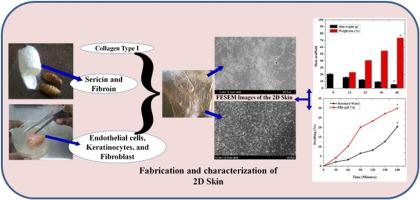Process Biochemistry ( IF 3.7 ) Pub Date : 2021-07-13 , DOI: 10.1016/j.procbio.2021.07.012 Rajesh Pandiyan , Abimanyu Sugumaran , Sumathi Samiappan , Parameshwaran Sengottaiyan , Sivasankaran Ayyaru , Selvakumar Dharmaraj , Veeramuthu Ashokkumar , Arivalagan Pugazhendhi

|
In the recent decade, tissue engineering has achieved noteworthy progress in artificial skin preparation. The present study is intended to harvest 2D skin from Bombyx mori cocoons and collagen type I with chicken endothelial cell culture for alleviating skin diseases like cancer. The Artificial 2D Skin is fabricated by seeding the endothelial cell, fibroblast and keratinocytes embedded in the silk sponge for 21 days, which results in a 2D skin. The fabricated 2D skin scaffold is subjected to material characterization and evaluated by UV absorption, FTIR, FESEM, swelling index, enzymatic degradation and antibacterial activity. The UV absorbance of sericin, fibroin and collagen are found at 215–240, 260−290 and 300 nm respectively. The results of FT-IR spectrum confirms the presence of proteinaceous substances. Moreover,FESEM shows a high degree of viable epidermis formation. The swelling index and enzymatic degradation is found as 30 %, 26.5 % respectively. The cell viabilitytest performed on different pus-forming bacteria which exhibited antibacterial property significantly at p<0.001. E. coliand has deprived viable conditions whencomparing with other organisms. From the above results, it is inferred that the 2D skin is equivalent to human skin which could be utilized for various skin therapy and tissue engineering.
中文翻译:

体外二维皮肤模型的制作和表征——尝试建立组织工程支架
近十年来,组织工程在人工皮肤制备方面取得了显着进展。本研究旨在从家蚕中收获 2D 皮肤蚕茧和 I 型胶原蛋白与鸡内皮细胞培养物用于减轻癌症等皮肤病。人工二维皮肤是通过将内皮细胞、成纤维细胞和角质细胞植入蚕丝海绵中 21 天制成的,从而形成二维皮肤。对制备的二维皮肤支架进行材料表征,并通过紫外吸收、FTIR、FESEM、溶胀指数、酶降解和抗菌活性进行评估。丝胶、丝心蛋白和胶原蛋白的紫外吸收分别在 215-240、260-290 和 300 nm 处发现。FT-IR 光谱的结果证实了蛋白质物质的存在。此外,FESEM 显示出高度有活力的表皮形成。发现溶胀指数和酶促降解分别为 30%、26.5%。p<0.001。与其他生物体相比,大肠杆菌缺乏生存条件。从以上结果可以推断,二维皮肤相当于人类皮肤,可用于各种皮肤治疗和组织工程。











































 京公网安备 11010802027423号
京公网安备 11010802027423号